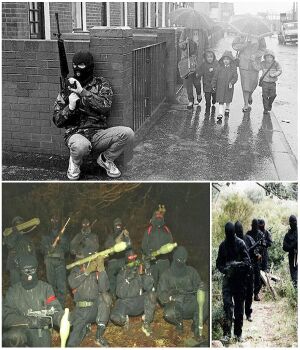Caerlanni War for Independence: Difference between revisions
4leafclovrs (talk | contribs) mNo edit summary |
4leafclovrs (talk | contribs) m (→External links) |
||
| Line 52: | Line 52: | ||
{{Template:Caerlannach topics}} | {{Template:Caerlannach topics}} | ||
[[Category:Caerlannach]] | [[Category:Caerlannach]] | ||
[[Category:Wars (Eurth)]] | |||
{{Eurth}} | {{Eurth}} | ||
Revision as of 08:11, 10 November 2024
| Caerlanni War for Independence | |||||||||
|---|---|---|---|---|---|---|---|---|---|
 Clockwise from top:
| |||||||||
| |||||||||
| Belligerents | |||||||||
|
|
| ||||||||
| Commanders and leaders | |||||||||
Military commanders:
|
Military commanders: TBA Political leaders: TBA | ||||||||
| Units involved | |||||||||
|
|
| ||||||||
| Strength | |||||||||
|
c. 80,000 GSC members c. 55,000 other insurgents | Total: TBA | ||||||||
| Casualties and losses | |||||||||
| TBA | TBA | ||||||||
| TBA | |||||||||
The Caerlanni War for Independence (Caerlanni Mealliagian: Cogadh Neamhspleáchais na gCaerlannaí) was a conflict fought between the Caerlanni Liberation Group (Grúpa Saoirse na gCaerlannaí; GSC) and the Royal Gotneskan Army from December 12th, 1972, to February 19th, 1976. The war commenced when Ronan Luathach and the GSC launched a coordinated assault on government structures within Dúnradh, the administrative center of Caerlannach under Gotneskan rule. This marked the beginning of an extended confrontation centered in urban areas, where Caerlanni insurgents engaged in prolonged battles against Gotneskan military forces. The conflict concluded with the signing of the Treaty of Fjallaverji, which formally recognized Caerlannach’s independence and established terms for the Gotneskan withdrawal. The Caerlanni War for Independence is widely studied for its unique combination of guerrilla tactics, political mobilization, and its pivotal role in reshaping Caerlannach’s sociopolitical landscape.
Scholars characterize the conflict as an asymmetric and low-intensity war, often framed as a struggle for national liberation. This confrontation encompassed both a tactical insurgency and a profound sociopolitical movement aimed at dismantling Gotneskan hegemony and establishing tribal autonomy across Caerlannach. The GSC drew broad support from various Caerlanni tribes, uniting them around shared objectives of political self-determination and cultural preservation. The war’s ideological foundation was underscored by the GSC’s commitment to indigenous governance, which contrasted sharply with Gotneskan centralized rule.
The origins of the war can be traced to May 1972, when Ronan Luathach returned to Caerlannach from political exile in Fulgistan. Drawing inspiration from contemporary anti-colonial movements, Luathach collaborated with a coalition of local separatist and nationalist factions to form the Caerlanni Liberation Group, including his former Caerlanni Separatist Group. That same year, he authored the "Manifesto of a Free Caerlannach", a document outlining his vision for an autonomous, decentralized society based on tribal governance and cooperation. The manifesto resonated across a broad spectrum of Caerlannach society, galvanizing support for independence and uniting disparate resistance groups under the GSC.
The formal outbreak of hostilities occurred with the Dúnradh Takeover on December 12, 1972, when GSC forces captured key government facilities in the city and announced the formation of the Caerlanni Free State. This decisive action triggered widespread uprisings, with similar revolts erupting in towns and villages across Caerlannach. While early uprisings experienced varying degrees of success, the GSC’s efforts were bolstered by extensive tribal support networks that facilitated intelligence-sharing, logistics, and supplies, complicating Gotneskan attempts to restore control.
The course of the war saw sustained, intense urban conflict, particularly in Caerlanni cities, where maneuver warfare tactics were employed by the tribes. The GSC’s reliance on guerrilla tactics, along with their deep familiarity with Caerlannach’s varied terrain, often enabled them to evade or outmaneuver the Gotneskan military. As the war progressed, the Caerlanni tribes demonstrated resilience through coordinated strategies, establishing supply chains and utilizing the surrounding geography to support their insurgency.
The conflict formally ended in February 1976 after the Gotneskan government, facing domestic fatigue, agreed to negotiate with the GSC leadership. The resulting Treaty of Fjallaverji outlined the terms of Gotneskan withdrawal and included a non-aggression pact between the two parties. The treaty marked the beginning of Caerlannach’s transition from colonial rule to a free state.